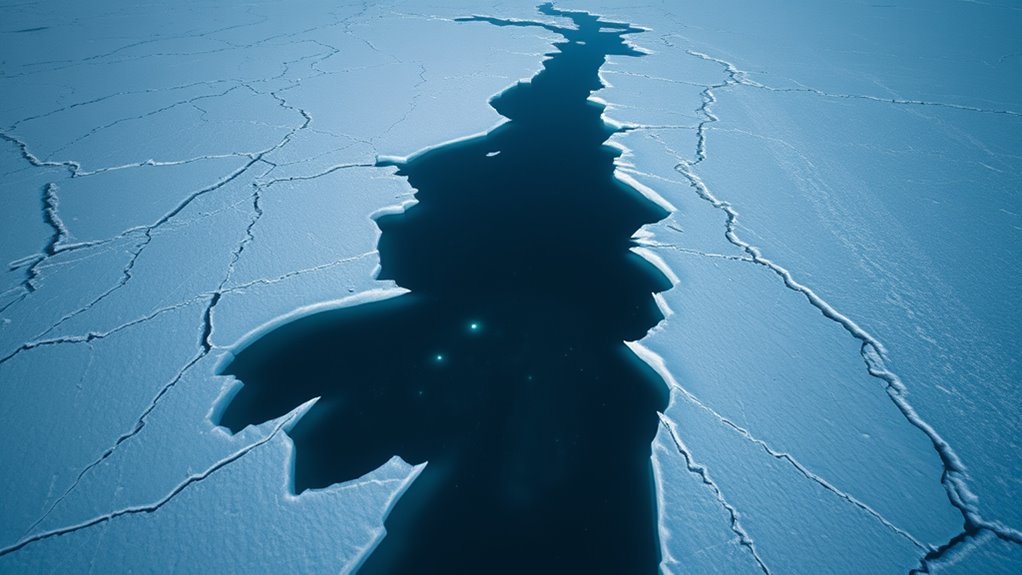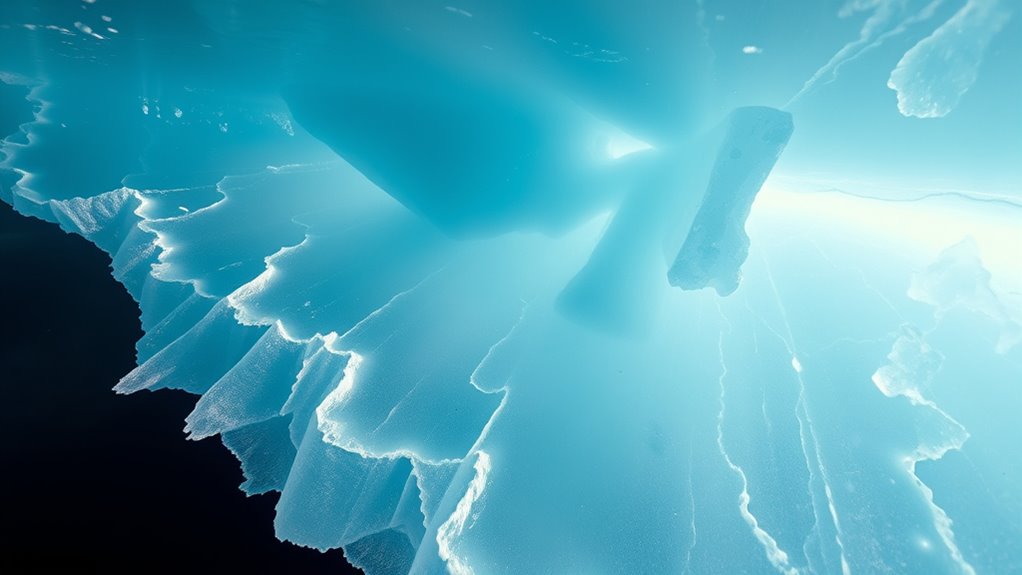Beneath over 4 kilometers of ice, Lake Vostok hosts a hidden ecosystem teeming with microbial life. This isolated environment stays liquid thanks to geothermal heat from radioactive decay and residual energy, supporting bacteria and archaea that survive without sunlight through chemosynthesis. These microbes thrive in extreme cold, high pressure, and darkness, creating a resilient community. Discover how this extraordinary ecosystem can reveal insights into life beyond Earth and what makes it uniquely resilient.
Key Takeaways
- Lake Vostok is a subglacial lake located over 4 km beneath Antarctica’s ice sheet, making it one of Earth’s most isolated ecosystems.
- Microbial communities in the lake survive through chemosynthesis, utilizing inorganic chemicals rather than sunlight.
- Geothermal heat prevents the lake from freezing completely, creating hydrothermal vents that provide energy and nutrients.
- The ecosystem offers insights into potential extraterrestrial habitats, such as subsurface oceans on icy moons like Europa and Enceladus.
- Scientific exploration of Lake Vostok reveals life’s resilience in extreme, isolated environments, expanding understanding of possible life beyond Earth.

Beneath more than 4 kilometers of ice, Lake Vostok remains one of Earth’s most isolated and mysterious ecosystems. Hidden beneath this vast ice sheet, the lake’s dark waters have been cut off from sunlight and the atmosphere for millions of years, creating a unique environment that intrigues scientists worldwide. Despite the extreme conditions, evidence suggests that microbial life thrives in this concealed world, sustained by phenomena like geothermal activity. You might imagine a landscape where life persists in the most unlikely conditions, but here, it’s a reality.
The microbial life within Lake Vostok has adapted to the extreme cold, high pressure, and lack of sunlight. These microorganisms, including bacteria and archaea, form the foundation of the lake’s ecosystem. They survive without photosynthesis, instead relying on chemosynthesis—using chemical energy from inorganic compounds. This process enables them to convert substances like hydrogen or methane, which may originate from geothermal activity beneath the lake’s icy crust, into energy. As a result, these microbes form a resilient, self-sustaining community that has persisted for thousands, perhaps millions, of years.
Geothermal activity plays an essential role in maintaining this hidden ecosystem. Deep within the Earth’s crust, heat generated by radioactive decay and residual geothermal energy warms the lake’s water, preventing it from freezing entirely. This heat creates localized hydrothermal vents or hot spots, which release mineral-rich fluids into the lake. These vents act as oases for microbial life, offering a source of energy and nutrients in an environment devoid of sunlight. You could think of these vents as underwater geysers, spewing life-sustaining chemicals that foster microbial communities hidden beneath layers of ice.
Scientists are intensely interested in Lake Vostok because its microbial life could resemble ecosystems that might exist on icy moons like Europa or Enceladus. The lake’s isolated environment offers clues about how life can survive under extreme conditions far from the energy sources we typically associate with life on Earth. The presence of geothermal activity suggests that even in the most inhospitable places, subsurface heat can create pockets of habitable environments.
Exploring Lake Vostok’s ecosystem isn’t just about understanding Earth’s extremes; it’s also about expanding our search for life elsewhere in the universe. The microbial communities thriving in these hidden waters demonstrate that life can persist in the most challenging circumstances, driven by geothermal energy and chemical processes underground. This secret world beneath the ice continues to challenge your understanding of what it means to find life and pushes the boundaries of science and exploration.
Frequently Asked Questions
How Does Lake Vostok’s Ecosystem Compare to Other Subglacial Lakes?
You might wonder how Lake Vostok’s ecosystem compares to other subglacial lakes. It’s unique because it acts as an analog ecosystem, helping scientists understand extreme environments. Its microbial diversity is surprisingly rich, similar to other subglacial lakes like Whillans and Enceladus. These ecosystems host microbes adapted to extreme conditions, offering insights into life’s resilience and potential extraterrestrial habitats. So, Lake Vostok’s ecosystem is a crucial piece of the puzzle.
What Potential Medical or Technological Discoveries Could Arise From Studying This Ecosystem?
Studying this ecosystem could lead you to groundbreaking medical and technological discoveries. By exploring extremophile adaptations, you might uncover novel biochemicals with potential medical applications, like new antibiotics or enzymes that operate under extreme conditions. These insights could revolutionize biotechnology, inspire new materials, or improve existing medicines. The ecosystem’s unique life forms hold the promise of releasing solutions to challenges in health, industry, and environmental management.
How Do Scientists Prevent Contamination When Accessing Lake Vostok?
You guarantee contamination prevention by using sterile drilling techniques when accessing Lake Vostok. Scientists sterilize all equipment and use clean, sealed systems to prevent introducing microbes or pollutants. They also monitor for contamination throughout the process, maintaining strict protocols. This careful approach helps protect the pristine environment, ensuring that the lake’s ecosystem remains untouched and the scientific findings remain valid for future research.
Could Life Forms From Lake Vostok Survive on Earth’S Surface?
You might wonder if lake Vostok’s life forms could survive on Earth’s surface. Given their extremophile survival skills, they can endure extreme conditions and might adapt to surface environments. However, their survival depends on factors like temperature, pressure, and nutrients. While some microbes may adapt, complex life forms are unlikely to survive surface conditions without specific adaptations. Understanding these extremophiles helps us grasp life’s resilience in harsh environments.
What Are the Long-Term Implications of Discovering Extraterrestrial Life There?
Imagine finding extraterrestrial analogs in Earth’s hidden depths; this discovery could revolutionize our understanding of life’s resilience. The long-term implications are profound, as it enhances astrobiological significance by suggesting life can thrive in extreme, isolated environments. You might realize that life exists beyond our planet, pushing the boundaries of exploration. Such findings could guide future missions, shaping how we search for and recognize extraterrestrial life in similarly harsh conditions elsewhere.
Conclusion
As you explore Lake Vostok’s secrets, it’s clear that uncovering this hidden world is no small feat. The ecosystem beneath 4 kilometers of ice proves that even in the coldest, most isolated corners of Earth, life finds a way. While this discovery opens new doors, it also reminds you that sometimes, the deepest mysteries are just waiting for the right person to crack the code. The surface is just the tip of the iceberg.









